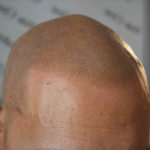We all see Instagram posts of before and afters or 1st,2nd and 3rd session progression as it relates to Scalp Micropigmentation. Marketing and photos can be misleading and set false expectations of what is realistic throughout the process. Understanding the process and expectations is very important and should be relayed to potential clients during the consultation.
I’d like to touch on the process and expectation for each session in general terms. SMP is typically done throughout 3-5 sessions realistically. For demonstration purposes, I will go through session progression as if we are talking about 3 sessions.
First session – This is the time to create the overall foundation. Depending on your artist, this may be low density or a time to create density and get a “wow” factor for a client. Whatever path your artist chooses, this is the time to get a base down and fill in the balding area. Directly after a 1st session, the results may look amazing but as the treatment heals and the redness dies down, you will likely see sections that have faded or disappeared all together and other sections that have remained. This can leave a patchy appearance but do not be alarmed, this is normal.
Second session – This is the time that your artist learns about your skin, how you heal, the technique used and any changes your artist must make in their technique. Each client’s skin is different and requires adjustments to be made to achieve the best results. During this session, your artist will be filling in any sessions that faded and blend the work from the first session. This is also the time to create the desired density the client is hoping to achieve or even make any changes to hairline design.
Third session – This may be your last session for a while or it may not. This session is typically used to blend and create final detailed touches. Some artists may use a different shade of pigment to create a dusted 3D look on this session.
As mentioned, each client is different so your artist should be working with you based on how the results are healing. A client’s scalp skin is different from inch to inch so if some sections impressions stay and others do not, you will need extra sessions. As a client, it can be a scary process when the results are not healing perfectly after every session; again this is common and each session is used to fill faded portions.
Marketing might make one believe that each session looks perfect. This is not the case and requires many sessions to make the final results you see advertised.
You can book a consultation with your local SMP provider or feel free to contact Dermimatch in Scottsdale, AZ at https://www.dermimatch.com and schedule a consultation.






